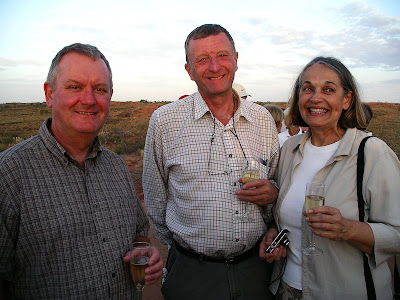The alarm is set for 4am as we have to get up to see it all over again in reverse. The coach picks us up at 4.55 and takes us to a different viewing area from the night before so the sun rises behind us. Supplied with tea and biscuits we head out to various viewpoints. It is hard to find a view that is not obscured by a tree or bush, or someone else with a camera and a big hat. Everyone takes loads of photos, most of which will look identical. Uluru changes from brown to red. We all head back to our coaches.
Excuse me while I remove my cynical head. Uluru really is magnificent, a huge monolithic rock standing out in a vast plain. The land around is semi-arid desert but surprisingly green. We didn’t see the supposed changing colours much in evidence, but I guess that depends on atmospheric conditions and dust refracting the sunlight from the horizon. The more dramatic the sunrise or sunset, the better will be the colours of Uluru.
Next on the itinerary is a cultural walk around part of the base of the rock. Our guide Rebecca shows us how features in the rock were interpreted to show fables and moral tales rather as stained glass windows in English churches portrayed parables. For the aborigines the whole landscape must have been like a picture book. We see some aboriginal ‘art’ in caves which were probably just marks on the wall to teach boys about hunting – like scrawl on a blackboard in a schoolroom.
We bus round to the climb point where you can ascend to the top of the rock. The local indigenous people ask visitors not to climb the rock, and we don’t get the chance anyway. Because of the heat, the climb is closed when we get there. People who set out earlier are now descending and some are obviously finding it difficult. It is extremely steep and some are sliding down on their backsides. I was a bit sorry in a way that I had come all this way and not had the opportunity to climb the rock. It was extremely hot, and when I saw how very steep it was I felt a bit queasy at the thought , not so much of going up, but I think that I would have been one of those tourists who would have needed to be rescued on their way down. It appeared to be precipitous. (Sue)
We get more tea and cake then set off for another walk on this side of Uluru. There are a number of caves used for various purposes, and sacred sites which we are not allowed to photograph – nor even to know their true significance.
Back at our room around midday we make up for lost sleep before the evening’s ‘Sound of Silence’ meal. As ever, a coach picks us up and heads out of the resort. This time though we rumble down a dirt road for a few kilometres until we halt by a small hill. We are situated somewhere between Uluru and Kata Tjuta on opposite horizons. The sun is setting almost behind Kata Tjuta. We ascend a sandy path to a paved area where we are given a glass of sparkling wine and canapés – kangaroo and crocodile canapés in fact, amongst others.
We meet some people who were on the tour this morning. More glasses of wine are drunk.
We make up a table of eight and descend the other side of the hill to an area of red sand with tables set out. We help ourselves at the buffet to more crocodile (tastes like chicken), kangaroo, lamb etc. and various side dishes, but with the tables lit only by small lamps it is very difficult to make out what one is eating. By this stage I had decided that I did not like crocodile, and was reasonably convinced that kangaroo would not become a favourite in the foreseeable future.(Sue)
A didgeridoo plays for a while and then we are told a bit about the instrument. We get a talk on the southern skies. Unfortunately it is a little cloudy so we don’t have the full stargazing experience. Wine continues to be poured. Dessert is served, and coffee and port, and we all have a good time. All too soon it is time to go back. Thank goodness we don’t have to get up at 4 in the morning tomorrow.











